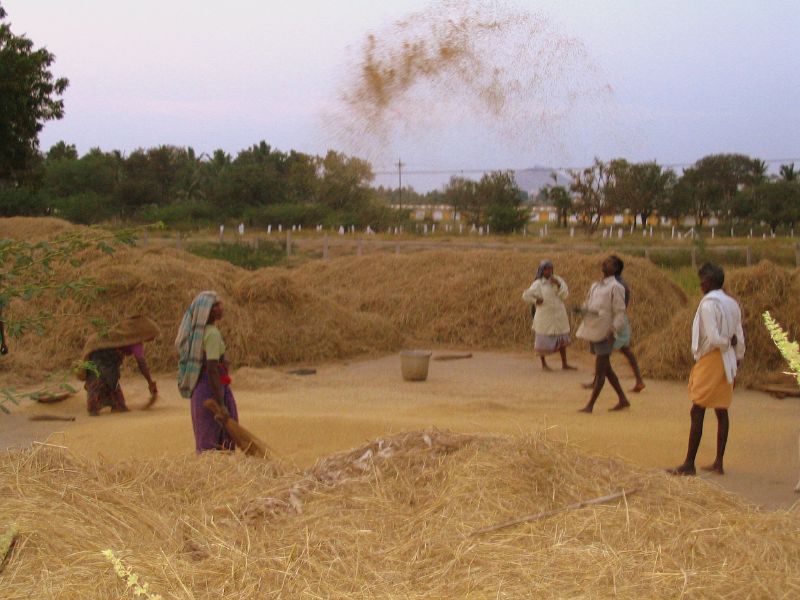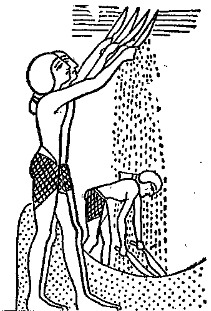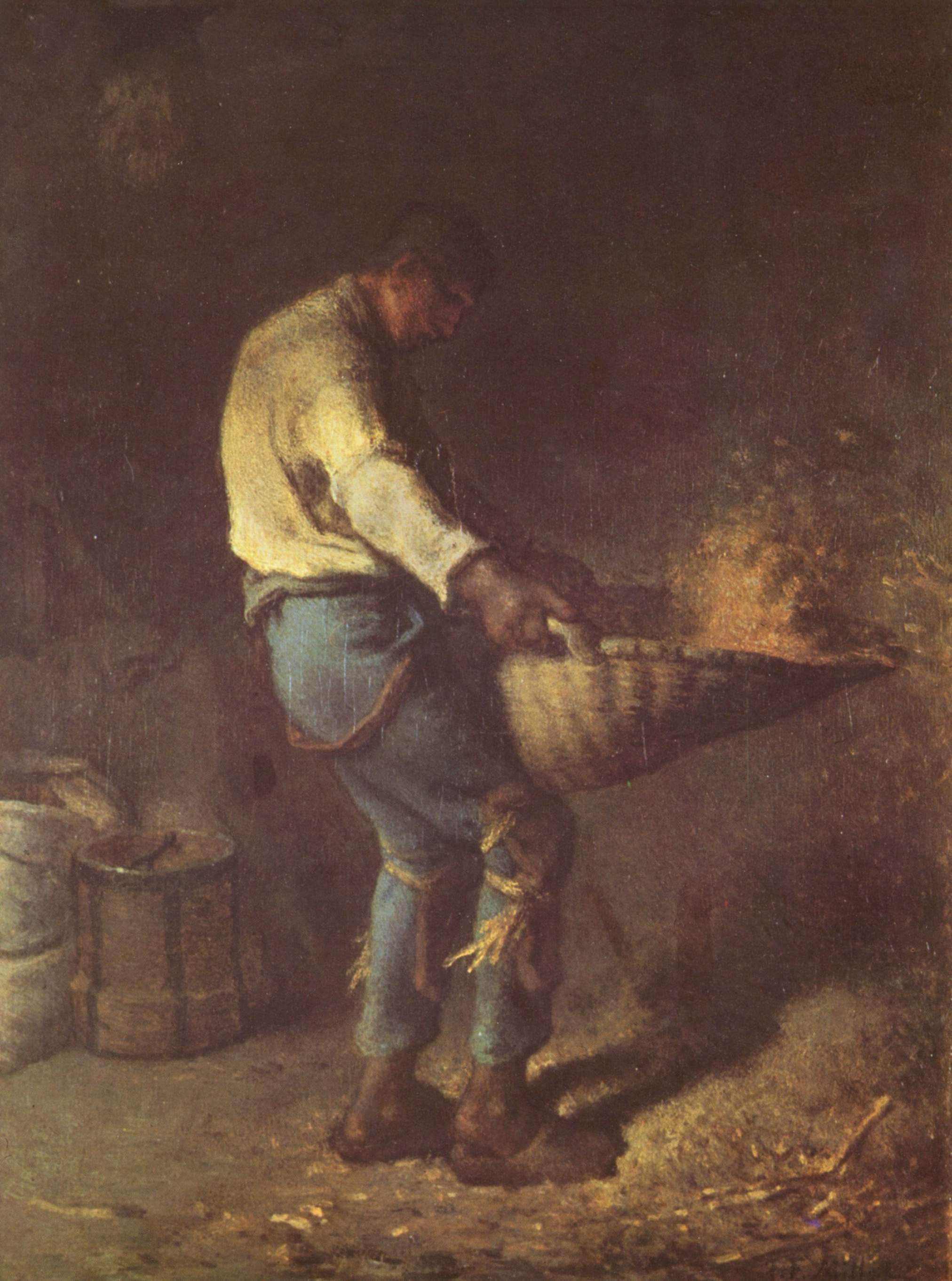Winnowing The Grain, Axum, Ethiopia (Detail) (3157508890).jpg on:
[Wikipedia]
[Google]
[Amazon]


 Winnowing is a process by which chaff is separated from grain. It can also be used to remove pests from stored grain. Winnowing usually follows
Winnowing is a process by which chaff is separated from grain. It can also be used to remove pests from stored grain. Winnowing usually follows
 In ancient China, the method was improved by mechanization with the development of the rotary winnowing fan, which used a cranked fan to produce the airstream. This was featured in Wang Zhen's book the '' Nong Shu'' of 1313 AD.
In ancient China, the method was improved by mechanization with the development of the rotary winnowing fan, which used a cranked fan to produce the airstream. This was featured in Wang Zhen's book the '' Nong Shu'' of 1313 AD.
 In Saxon settlements such as one identified in Northumberland as Bede's Ad Gefrin (now called
In Saxon settlements such as one identified in Northumberland as Bede's Ad Gefrin (now called
 In 1737 Andrew Rodger, a farmer on the estate of
In 1737 Andrew Rodger, a farmer on the estate of


threshing
Threshing, or thrashing, is the process of loosening the edible part of grain (or other crop) from the straw to which it is attached. It is the step in grain preparation after reaping. Threshing does not remove the bran from the grain.
History ...
in grain preparation. In its simplest form, it involves throwing the mixture into the air so that the wind blows away the lighter chaff, while the heavier grains fall back down for recovery. Techniques included using a winnowing fan (a shaped basket shaken to raise the chaff) or using a tool (a winnowing fork or shovel) on a pile of harvested grain.
In Greek culture
The winnowing-fan (λίκνον 'líknon'' also meaning a "cradle") featured in the rites accordedDionysus
In ancient Greek religion and myth, Dionysus (; grc, Διόνυσος ) is the god of the grape-harvest, winemaking, orchards and fruit, vegetation, fertility, insanity, ritual madness, religious ecstasy, festivity, and theatre. The Roma ...
and in the Eleusinian Mysteries
The Eleusinian Mysteries ( el, Ἐλευσίνια Μυστήρια, Eleusínia Mystḗria) were initiations held every year for the cult of Demeter and Persephone based at the Panhellenic Sanctuary of Elefsina in ancient Greece. They are th ...
: "it was a simple agricultural implement taken over and mysticized by the religion of Dionysus," Jane Ellen Harrison
Jane Ellen Harrison (9 September 1850 – 15 April 1928) was a British classical scholar and linguist. Harrison is one of the founders, with Karl Kerenyi and Walter Burkert, of modern studies in Ancient Greek religion and mythology. She ...
remarked. ''Dionysus Liknites'' ("Dionysus of the winnowing fan") was wakened by the Dionysian women, in this instance called ''Thyia
In Greek mythology, Thyia (; grc, Θυία ''Thuia'' derived from the verb ''θύω'' "to sacrifice") was a female figure associated with cults of several major gods.
Mythology
In the Delphic tradition, Thyia was also the naiad of a spring ...
des'', in a cave on Parnassus
Mount Parnassus (; el, Παρνασσός, ''Parnassós'') is a mountain range of central Greece that is and historically has been especially valuable to the Greek nation and the earlier Greek city-states for many reasons. In peace, it offers ...
high above Delphi; the winnowing-fan links the god connected with the mystery religion
Mystery religions, mystery cults, sacred mysteries or simply mysteries, were religious schools of the Greco-Roman world for which participation was reserved to initiates ''(mystai)''. The main characterization of this religion is the secrecy as ...
s to the agricultural cycle, but mortal Greek babies too were laid in a winnowing-fan. In Callimachus
Callimachus (; ) was an ancient Greek poet, scholar and librarian who was active in Alexandria during the 3rd century BC. A representative of Ancient Greek literature of the Hellenistic period, he wrote over 800 literary works in a wide varie ...
' ''Hymn to Zeus'', Adrasteia
In ancient Greek religion and mythology, Adrasteia (; , ), also spelled Adrastia, Adrastea, Adrestea, Adastreia or Adrasta), originally a Phrygian mountain goddess, probably associated with Cybele, was later a Cretan nymph, and daughter of Meli ...
lays the infant Zeus in a golden ''líknon'', her goat suckles him and he is given honey. In the ''Odyssey
The ''Odyssey'' (; grc, Ὀδύσσεια, Odýsseia, ) is one of two major ancient Greek epic poems attributed to Homer. It is one of the oldest extant works of literature still widely read by modern audiences. As with the ''Iliad'', th ...
'', the dead oracle Teiresias
In Greek mythology, Tiresias (; grc, Τειρεσίας, Teiresías) was a blind prophet of Apollo in Thebes, famous for clairvoyance and for being transformed into a woman for seven years. He was the son of the shepherd Everes and the nymph ...
tells Odysseus to walk away from Ithaca with an oar until a wayfarer tells him it is a winnowing fan (i.e., until Odysseus has come so far from the sea that people don't recognize oars), and there to build a shrine to Poseidon.
China
 In ancient China, the method was improved by mechanization with the development of the rotary winnowing fan, which used a cranked fan to produce the airstream. This was featured in Wang Zhen's book the '' Nong Shu'' of 1313 AD.
In ancient China, the method was improved by mechanization with the development of the rotary winnowing fan, which used a cranked fan to produce the airstream. This was featured in Wang Zhen's book the '' Nong Shu'' of 1313 AD.
In Europe
 In Saxon settlements such as one identified in Northumberland as Bede's Ad Gefrin (now called
In Saxon settlements such as one identified in Northumberland as Bede's Ad Gefrin (now called Yeavering
Yeavering () is a hamlet (place), hamlet in the north-east corner of the civil parish of Kirknewton, Northumberland, Kirknewton in the English county of Northumberland. It is located on the River Glen, Northumberland, River Glen at the northern ...
) the buildings were shown by an excavator's reconstruction to have opposed entries. In barns a draught created by the use of these opposed doorways was used in winnowing.
The technique developed by the Chinese was not adopted in Europe until the 18th century when winnowing machines used a 'sail fan'. The rotary winnowing fan was exported to Europe, brought there by Dutch sailors between 1700 and 1720. Apparently, they had obtained them from the Dutch settlement of Batavia in Java, Dutch East Indies. The Swedes imported some from south China at about the same time and Jesuits had taken several to France from China by 1720. Until the beginning of the 18th century, no rotary winnowing fans existed in the West.
In the United States
The development of thewinnowing barn
Winnowing barns (or winnowing houses) were structures commonly found in South Carolina on antebellum rice plantations. A winnowing barn consists of a large shed on tall posts with a hole in the floor. Raw, husked rice was carried up into the barn ...
allowed rice plantations in South Carolina
)'' Animis opibusque parati'' ( for, , Latin, Prepared in mind and resources, links=no)
, anthem = " Carolina";" South Carolina On My Mind"
, Former = Province of South Carolina
, seat = Columbia
, LargestCity = Charleston
, LargestMetro = ...
to increase their yields dramatically.
Mechanization of the process
 In 1737 Andrew Rodger, a farmer on the estate of
In 1737 Andrew Rodger, a farmer on the estate of Cavers
Caving – also known as spelunking in the United States and Canada and potholing in the United Kingdom and Ireland – is the recreational pastime of exploring wild cave systems (as distinguished from show caves). In contrast, speleology is ...
in Roxburghshire, developed a winnowing machine for corn, called a 'Fanner'. These were successful and the family sold them throughout Scotland for many years. Some Scottish Presbyterian ministers saw the fanners as sins against God, for the wind was a thing specially made by him and an artificial wind was a daring and impious attempt to usurp what belonged to God alone.Chambers, Robert (1885). ''Domestic Annals of Scotland''. Edinburgh: W & R Chambers. p. 397. As the Industrial Revolution
The Industrial Revolution was the transition to new manufacturing processes in Great Britain, continental Europe, and the United States, that occurred during the period from around 1760 to about 1820–1840. This transition included going f ...
, the winnowing process was mechanized by the invention of additional winnowing machines, such as fanning mills.
See also
*Rice huller
A rice huller or rice husker is an agricultural machine used to automate the process of removing the chaff (the outer husks) of grains of rice. Throughout history, there have been numerous techniques to hull rice. Traditionally, it would be p ...
*Rice pounder
A rice pounder is an agricultural tool, a simple machine that is commonly used in Southeast Asia to dehull rice or to turn rice into rice flour. The device has similar functionality to a mortar and pestle, but with more mechanical advantage to ...
*Sieving
A sieve, fine mesh strainer, or sift, is a device for separating wanted elements from unwanted material or for controlling the particle size distribution of a sample, using a screen such as a woven mesh or net or perforated sheet material. ...
*Threshing
Threshing, or thrashing, is the process of loosening the edible part of grain (or other crop) from the straw to which it is attached. It is the step in grain preparation after reaping. Threshing does not remove the bran from the grain.
History ...
*Winnowing (sedimentology)
In sedimentology, winnowing is the natural removal of fine material from a coarser sediment
Sediment is a naturally occurring material that is broken down by processes of weathering and erosion, and is subsequently transported by the actio ...
References
External links
{{Wiktionary-inline, winnowing Harvest Separation processes Grain production sn:kuwurutsa ja:唐箕